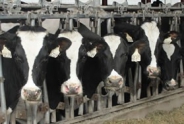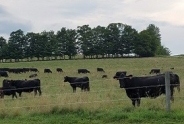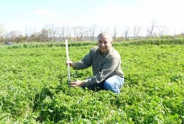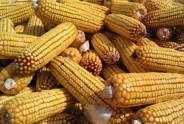Field Crop Update June 7, 2023
Erik Smith, Area Field Crop Specialist/Team Leader
Central New York Dairy and Field Crops
1. Field Observations
2. Growing Degree Days and Weather Outlook
3. Pest and Disease Monitoring
1. Field Observations
The Update is a day early this week, so we won't have the latest US Drought Monitor map (updated every Thursday). But even with the recent rain events, our hayfields and pastures are showing the effects of the lack of rain to this point. Some patches or entire fields may have gone dormant from the lack of moisture. So if you're getting close to your second-cut timing and the regrowth has been negligible, is it better to cut, or not to cut?
Like most things, this depends. Mostly on the amount of regrowth you've seen since your last cutting. If you haven't seen much of anything since your last cut, you may be wasting time and diesel. But Dairy Forage Systems Specialist Joe Lawrence (PRO-DAIRY) reminds us that clipping forages that have "shut down" due to drought can stimulate growth (this response may be more pronounced in alfalfa than in grass, though alfalfa is more drought-tolerant to begin with due to its deep roots), but only if there is enough moisture to support that new growth. Clipping grasses before the return of moisture is unlikely to cause much regrowth because the conditions that induced dormancy in the first place are still present. But once moisture returns, cutting will cause grass stands to fill out by tillering, though the full effect of that tillering may not be immediate. By the time you read this, most places in our region will have seen some rain, and will have more in the forecast. So keep an eye on your hayfields as they reach your desired maturity and decide whether it's worth it to cut and harvest or just to cut in order to jump-start their regrowth. While it may be tempting to do so, don't continue to hold out until "there's enough to harvest", because you may be harvesting a ton of undigestible fiber. And above all, do not give in to the temptation to cut the stand short to try and squeeze the stand for whatever you can get. This will only exacerbate the stress, delaying regrowth and recovery until even later, and will result in increased levels of undigestible fiber and ash.
Here's some more reading on managing drought-stressed forages:
https://u.osu.edu/beef/2012/08...
https://extension.psu.edu/to-m...
https://www.canr.msu.edu/news/...
https://extension.psu.edu/mana...
2. Growing Degree Days (See: Climate Smart Farming Growing Degree Day Calculator)
Growing degree days (GDD) are calculated by taking the average daily temperature and subtracting the base temperature for development of a given organism ((High + Low)/2 - base temp = GDD). For corn silage, we are using base 50/86, as corn development starts at 50 degrees F and ceases above 86. Check your location and planting date:


3. Pest and disease monitoring
Cereal Leaf Beetle
Be on the lookout if you've had problems in the past. Numbers are increasing each year, all over the state.
Alfalfa weevil
Jeff Miller (Agronomist, CCE-Oneida) is reporting damage from alfalfa weevil, so be on the lookout. For more, see his report
Black cutworm (BCW) and True armyworm (TAW)
Numbers are down again this week, but we have reports of black cutworm damage from western NY, so check your fields until V6 (~12") for cutworm damage.



Fusarium head blight in winter grains
As winter grains begin and continue to flower, now would be the time to decide whether to protect crops from fusarium head blight. According to the Fusarium Risk Tool (https://www.wheatscab.psu.edu/ ), the 6-day risk forcast in our region is currently low:
NY Jun 1, 2023 Gary Bergstrom, Extension Plant Pathologist, Cornell University
Winter wheat heads have emerged from the boot nearly everywhere and many are now flowering (yellow anthers visible) in fields across New York State. This is a critical time for making a fungicide spray decision. The fungicide products Caramba, Miravis Ace, Prosaro, Prosaro Plus, and Sphaerex are each labeled on wheat in New York and are effective in suppression of Fusarium head blight (FHB) and deoxynivalenol (DON) mycotoxin contamination. An application of these fungicide products should be based on FHB risk as well as the risks of powdery mildew, rusts, and fungal leaf blotches in the upper canopy based on scouting of individual fields. There is an application window of approximately 7 days starting at beginning of flowering in which reasonable FHB and DON suppression can be expected. Though the calculated risk of FHB infection is currently low due to dry conditions, the risk level may change in following days. Also consider microenvironments near lakes, in river valleys and next to woods that tend to have persistent dew, and other fields that have a history of mycotoxin contamination. Check the Fusarium Risk Assessment Tool (www.w.heatscab.psu.edu/ ) and your local weather forecast frequently.
You are invited to attend Cornell's 35th Annual Small Grains Management Field Day at Fleur De Lis Brewery in Seneca Falls on June 8. Visit https://cals.cornell.edu/2023-small-grains-managment-field-day to view the agenda and pre-register (free)!

Field Crop Update June 7, 2023 (pdf; 743KB)
Upcoming Events
2026 Dairy Day
January 13, 2026 : Dairy Day - Hamilton
Hamilton, NY
Lunch included
January 14, 2026 : Dairy Day - Ballston Spa
Ballston Spa, NY
Lunch included
2026 Corn & Soybean Day
January 20, 2026 : Corn & Soybean Day - Hamilton
Hamilton, NY
Lunch included. 2.75 DEC Credits available
January 21, 2026 : Corn & Soybean Day - Ballston Spa
Ballston Spa, NY
Lunch included. 2.75 DEC Credits available
Announcements
Statewide Field Crop Pathology Needs Assessment Survey
Your input is wanted for identifying priorities!Sign Up for Our Weekly E-Newsletter
We send out a bi-weekly e-newsletter that has announcements, upcoming programs, and opportunities for you! Registration is quick, easy, and free. Click here to sign up today!Farmers Can Join MeatSuite For Free!
MeatSuite.com is a free resource provided by Cornell University where NY meat farmers can create a farm profile and list their bulk (wholes, halves, quarters) and bundled (i.e. Grilling Bundle) meat products.Why should farmers join?
1. It's free and easy!
2. Connect with more local customers. In the past year the MeatSuite.com farm directory had 8,300 visits from New York consumers. Farm profiles get as many as 25 views per month from potential local customers. We also spotlight MeatSuite farms on social media and bring attention and purchases to farms through highlights and giveaways.
How do I join?
Farmers can visit https://www.meatsuite.com/farmers/ to create a free farm profile. You must list at least one product for your farm's profile to go live. You'll also have access to Cornell's free Meat Price Calculator, a helpful tool for pricing your meat to make a profit.
While you're on MeatSuite, check out the "Creating Consumer-Friendly Bulk Meats" publication on the log-in page. It has tips on how to create bulk meat products that are easier for first-time buyers to say "yes" to.
If you have any questions as you create your farm profile or products, we're here to help! Please email Matt LeRoux at mnl28@cornell.edu.




